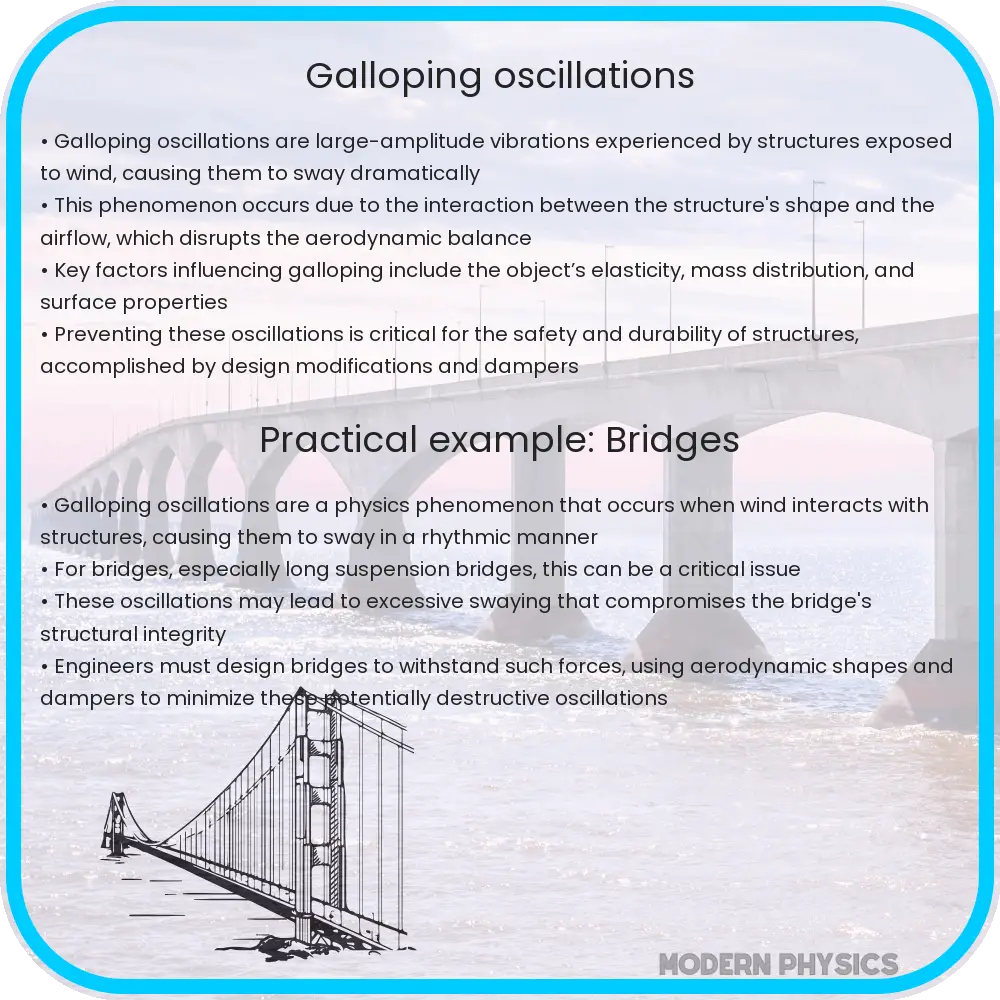Galloping oscillations in hydrodynamics describe self-excited vibrations in structures due to fluid flow, potentially leading to resonant and destructive outcomes.

Galloping Oscillations in Hydrodynamics: An Exploration of Stability and Flow
Galloping oscillations, a phenomenon primarily observed in structures subjected to fluid flow, offer a vivid demonstration of the complex interplay between aerodynamic forces and structural behavior. Commonly impacting overhead transmission lines, tall signposts, and even skyscrapers, these oscillations can lead to significant structural damage if not properly managed. This article explores the nature of galloping oscillations, their underlying physics, and the principles that can be utilized to control their effects.
Understanding Galloping Oscillations
Galloping oscillations arise from the interaction between a structure and the fluid flow around it, typically air. The phenomenon is a type of self-excited vibration with the potential to cause destructive resonant oscillations. The key to understanding galloping lies in the concept of aerodynamic stability and the specific shape of the structure interacting with the flow.
At the core of these oscillations is the destabilizing force generated by the flow around an object. This force is heavily dependent on the object’s geometry and the angle of attack—the angle between the oncoming flow and the structure. A classic example is an iced-over power line, where the ice changes the line’s shape and makes it more prone to galloping under strong winds.
The Role of Hydrodynamic Stability
Hydrodynamic stability, or rather instability, plays a key role in the onset of galloping oscillations. When a structure exposed to flow becomes unstable, small perturbations in the flow can grow over time, leading to larger and larger oscillations. The critical parameters influencing this stability include the Reynolds number, which characterizes the flow regime as laminar or turbulent, and the structural damping characteristics.
Mathematically, the stability of a system in flow can be analyzed using the quasi-steady theory. This theory simplifies the dynamic system to a series of steady states, each defined by the angle of attack and the flow velocity. The equation typically used to describe the force distribution over the object is:
- \( F = \frac{1}{2} \rho v^2 A C_L \)
Where:
- \( F \) is the aerodynamic force,
- \( \rho \) is the air density,
- \( v \) is the flow velocity,
- \( A \) is the surface area exposed to the flow, and
- \( C_L \) is the lift coefficient, which varies with the angle of attack.
An increase in the angle of attack generally increases the lift coefficient, amplifying the lift force exponentially. When this lift force surpasses the damping forces and the structural restoring force, the system undergoes galloping oscillations.
Flow-Induced Vibrations and Critical Velocity
The onset of galloping is highly dependent on the velocity of the fluid flow. There exists a critical velocity above which the damping characteristics of the structure are insufficient to suppress the energy input from the aerodynamic forces. This critical velocity can be approximated by the following formula:
- \( V_c = \sqrt{\frac{k}{C \cdot A \cdot \rho}} \)
Here:
- \( V_c \) is the critical velocity,
- \( k \) is the spring constant of the structure,
- \( C \) is an aerodynamic constant depending on the shape of the object and the angle of attack,
- \( A \) is the reference area, and
- \( \rho \) is the air density.
When the actual flow velocity exceeds this critical value, the energy contributed by the fluid exceeds the energy dissipated by the damping forces, leading to progressive amplification of oscillations.
Mitigation Techniques for Galloping Oscillations
To prevent the detrimental effects of galloping oscillations, engineers employ various mitigation strategies. These strategies are designed to either increase the damping characteristics of the structure or alter its aerodynamic properties to reduce susceptibility to oscillations.
- Structural Damping: Adding dampers or increasing the structural damping capacity can absorb the energy of oscillations, preventing their growth.
- Aerodynamic Modification: Modifying the shape of the structure to influence the aerodynamics can be highly effective. For instance, installing spoilers or riblets can reduce lift forces generated at higher angles of attack.
- Vibration Absorbers: Specific devices known as tuned mass dampers can be attached to structures. These devices vibrate out of phase with the primary structure and help in reducing the amplitude of oscillations.
These techniques often require a careful balance between cost, practical feasibility, and the specific environmental conditions the structure will face.
Future Directions in Understanding and Controlling Galloping Oscillations
As engineering materials and technology advance, so too does our capacity to counteract galloping oscillations more effectively. Research is continually being conducted on new materials with better damping properties and innovative designs that alter flow characteristics in beneficial ways. Additionally, computational fluid dynamics (CFD) simulations play a crucial role in predicting the complex interactions between air flows and structures, allowing for more precise design modifications before actual implementation.
Ultimately, the control of galloping oscillations not only improves the longevity and safety of structures but also enhances their efficiency and functionality in various industrial and architectural applications.
Conclusion
Galloping oscillations are a compelling example of the dynamic interactions between structures and fluid flows. Understanding the physics behind these oscillations enables engineers to devise strategies to prevent potentially disastrous consequences. Through a combination of structural modifications, innovative damping solutions, and advancements in simulation technologies, the challenge of managing galloping oscillations is becoming increasingly manageable. As the field progresses, we can anticipate even more sophisticated approaches to controlling these and other related phenomena in hydrodynamic environments.
This exploration not only underscores the importance of interdisciplinary knowledge in engineering but also highlights the need for continuous innovation in tackling the complexities of real-world physical phenomena.
